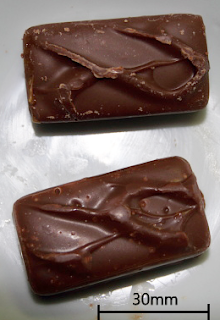 |
| Autosub6000 being launched! (I love that they've had to write 'harmless scientific instrument' on it in case it's mistaken for a giant yellow torpedo! |
Deep-sea fish (particularly abyssal ones) are pretty difficult to study, partly because as the depth increases there's less and less food available which means fewer and fewer fish are able to survive. So, by the time you reach the abyssal plains at 4000-6000m, there are relatively few individuals around to find. One way around this problem is to use baited camera systems to lure the fish into your photographs, and it is an extremely efficient way of assessing the abundance and diversity of scavenging species in an ecosystem. However, scavenging species only account for around 25% of the total fish diversity in the deep waters of the north-east Atlantic, so we need to use other techniques to identify the other 75%. A potential solution is to use unbaited cameras (such as Bathysnap), set to take images every few hours over several months then record which species pass by the camera in that time. Alternatively, we could catch specimens using trawl surveys to cover a larger area (which has the additional benefit that we can get definitive identifications for the species we catch), but we can't tell exactly whereabouts each fish was captured along the trawl's path.
However, none of these methods are really suitable for examining what the distribution patterns of fish are on the seafloor (i.e. do they cluster together or are they spread evenly over the seabed?) or how they respond to variations in habitat (e.g. how they react to the presence of hills or hard substrate), which are fairly fundamental questions to consider in understanding the ecology of any species. This is where Autosub comes into the picture.
 |
| The forward-looking camera & flash on Autosub which I use to look for fish. |
As an AUV (Autonomous Underwater Vehicle), Autosub can be programmed to dive to the seafloor, follow a survey route while operating any on-board equipment (like cameras or sonar systems) and then return to the surface and the research ship without requiring any human intervention during its mission. Not only does this free the ship to conduct other work while the Autosub is getting on with its surveys, but it can also be programmed to conduct extremely long or complex surveys which may not be feasible using other methods. For our work, Autosub was set to conduct photographic transects roughly 35km - 90km in length, taking photographs every 0.86 seconds at a speed of around 1m per second. In case your mental arithmetic is a bit creaky, that's approximately 4200 photographs per hour!
EDIT: Hooray! I've had the OK to post a few images, so here are a few of the better ones. They're cropped from a 5MP camera so they're not amazing quality, but they do the job!
 |
| Bathysaurus sp. (lizardfish) is an ambush predator with rather a lot of teeth. They're not really orange, but the camera has a funny colour balance going on that I've not fixed yet. |
 |
| A (not-colour-corrected) grenadier from yesterday's mission. |
 |
| And another little grenadier from the first mission we did. |
Anyway, after a rather full-on five days or so of AUV operations and between the two stills cameras mounted on Autosub, we've amassed well over 550,000 images and covered around 150km of abyssal seabed! A preliminary look through the photos is showing a decent number of fish as well which is brilliant news and means I'm going home with a really nice set of (pretty damn exciting) data! All of this is exceptionally cool, but sadly combines with the 100 hours of ROV footage from last month's cruise to sound the final death knell for my social life. Well, that and the prospect of several weeks on an Angolan oil rig at the end of the year, but that's still to be confirmed...
 |
| Examples of the rubbish we trawled up from the Porcupine Abyssal Plain during last year's cruise. |
Finally, Jen Durden and I have written up a blog for the NOC's 'Picturing the Deep' blog which will hopefully go up online tomorrow (Tuesday at the latest I'd expect) so you can see some of it there at least in the meantime!


































